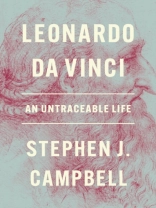How our image of the Renaissance’s most famous artist is a modern myth
Leonardo da Vinci (1452–1519) never signed a painting, and none of his supposed self-portraits can be securely ascribed to his hand. He revealed next to nothing about his life in his extensive writings, yet countless pages have been written about him that assign him an identity: genius, entrepreneur, celebrity artist, outsider. Addressing the ethical stakes involved in studying past lives, Stephen J. Campbell shows how this invented Leonardo has invited speculation from figures ranging from art dealers and curators to scholars, scientists, and biographers, many of whom have filled in the gaps of what can be known of Leonardo’s life with claims to decode secrets, reveal mysteries of a vanished past, or discover lost masterpieces of spectacular value.
In this original and provocative book, Campbell examines the strangeness of Leonardo’s words and works, and the distinctive premodern world of artisans and thinkers from which he emerged. Far from being a solitary genius living ahead of his time, Leonardo inhabited a vibrant network of artistic, technological, and literary exchange. By investigating the politics and cultural tensions of the era as well as the most recent scholarship on Leonardo’s contemporaries, workshop, and writings, Campbell places Leonardo back into the milieu that shaped him and was shaped by him. He shows that it is in the gaps and contradictions of what we know of Leonardo’s life that a less familiar and far more historically significant figure appears.
关于作者
Stephen J. Campbell is the Henry and Elizabeth Wiesenfeld Professor in the Department of the History of Art at Johns Hopkins University. His books include
Andrea Mantegna: Humanist Aesthetics, Faith, and the Force of Images and
The Endless Periphery: Toward a Geopolitics of Art in Lorenzo Lotto’s Italy.












